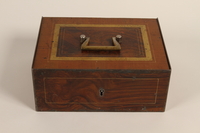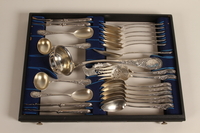Overview
- Description
- File of documents relating to the resitution efforts of Manfred Lovin (Loewin), working through the United Restitution Organization and filing on behalf of deceased family members. Includes decisions in the case, statements for money rewards, and documents for transfer of funds.
- Date
-
1958-1972
- Collection Creator
- Manfred Lovin
- Biography
-
Manfred Lovin (née Löwin) was born on March 9th, 1892 in Berlin, the son of Leopold and Clothilde Löwin. The Löwin family was relatively prosperous, making a comfortable living in the textile industry. Religiously, the Jewish family was liberal. Manfred received the benefits of a classical education at the Kaiser Wilhelm Gymnasium, and later went on to business school. At the outbreak of World War I, Manfred served as a non-commissioned officer in a cavalry regiment of the German Army. After the war, Lovin founded a successful radio components manufacturing company, and came into contact with a number of individuals who would later help him escape Germany, most notably Albert Speer and Hjalmar Schacht. Ironically, the three men belonged to the same fraternal organization (Bruderschaft). In 1923, he married Erna Kowalsky, a pianist and singer. The couple had two children, Ursula and Gerda, of whom both perished in the Holocaust. In 1937 Lovin was arrested for “race pollution” and sentenced to 15 months imprisonment at Brandenburg prison. Lovin served the last six months of his sentence at the Sachenhausen Concentration Camp. In April 1939, Lovin secured a divorce. Three months later, with Hjalmar Schacht’s intercession, Lovin received permission to leave Germany and immigrate to the United States. The privilege was not extended to any of Lovin’s family. Manfred Lovin arrived in New York in May 1939. With the aid of the Koenigsberger family of Washington, DC, Lovin devoted much of his time and energies from 1939, to the end of the war attempting to get his family out of Germany. He was unsuccessful. In 1942, Lovin moved to Washington, DC and worked at Hecht’s department store. On the 30th of July 1943, he married Jenice Jaffa. On December 29th, 1958 Manfred Lovin retired from Hecht’s department store. He died in 1991, age 99. Manfred Lovin’s family name was spelled Löwin, Löewin, Lövin, Lowin, Loewin, and Lovin at various times in his life.
Physical Details
- Language
- German
- Genre/Form
- Case files.
- Extent
-
.
2 microfiche.
- Extent
-
1 folder
- System of Arrangement
- Arrangement is thematic
Rights & Restrictions
- Conditions on Access
- There are no known restrictions on access to this material.
- Conditions on Use
- The Museum is in the process of determining the possible use restrictions that may apply to material(s) in this collection.
Keywords & Subjects
- Topical Term
- Restitution and indemnification claims (1933-)
- Personal Name
- Lovin, Manfred, 1892-1991. Lipman, Eugene, 1919-
- Corporate Name
- United Restitution Organization
Administrative Notes
- Holder of Originals
-
United States Holocaust Memorial Museum
- Legal Status
- Permanent Collection
- Provenance
- The URO case file of Manfred Lovin became the property of Rabbi Eugene Lipman and his wife, Esther, as personal representatitves of Lovin's estate. The case file was received at the United States Holocaust Memorial Museum in the Collections Department along with several artifacts and photographs. The case file was transferred to the United States Holocaust Memorial Museum Archives on 17 Feb. 1992 by Jacek Nowakowski of the Collections Department.
- Record last modified:
- 2023-08-25 15:50:21
- This page:
- https://collections.ushmm.org/search/catalog/irn503541
Download & Licensing
- Copyright Not Evaluated
- Terms of Use
- This record is not digitized and cannot be downloaded online.
In-Person Research
- Request 7 Days in Advance of Visit
- Plan a Research Visit
-
Request in Shapell Center Reading Room
Bowie, MD
Contact Us
Also in Manfred Lovin collection
Contains materials related to the life of Manfred Lovin, a German Jew, and his escape from Nazi Germany along with information concerning the Lovin family and their fates. Some of these materials may be combined into a single collection in the future.
Date: 1892-1979

Strongbox
Object
Used by Manfred Lövin to transport his personal belongings from Germany to the United States, 1939.
Manfred Lovin papers
Document
Contains materials related to the life of Manfred Lovin, a German Jew, and his escape from Nazi Germany, along with information concerning the Lovin family and their fates.




